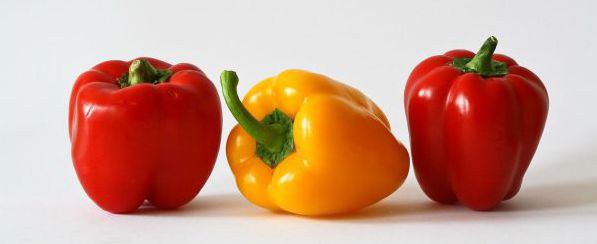There's more!
Once all the peppers have been picked, the last leg of the leaves’ and stems’ journey takes them to the compost heap. Researchers from Jülich, Aachen and Bonn don’t think that this needs to be the case. They are investigating whether valuable substances can be extracted from the unused plant leftovers for use in medicine, cosmetics and the food industry. In the end, the vegetable farmer could profit: he sells not only the fruit, but also the accessory agents.
They are crisp, fresh and healthy: bell peppers. The fruit from the nightshade family has long since landed in salads, frying pans or on the grill in all colours all year round. It’s no wonder that farmers in Germany are growing more peppers. Classically, they sow the peppers in the greenhouse, take good care of them, harvest the bell peppers and sell them. Leaves, stems and roots end up as compost. Dr. Anika Wiese-Klinkenberg from the Plant Sciences (IBG-2) section finds that these are “squandered resources”.
Valuable substances

In the TaReCa joint research project, the plant physiologist, together with colleagues from RWTH Aachen University and the University of Bonn, is developing technologies to utilise the plant’s leaves and stems as well: “After the fruit harvest, we use the plant as a production factory for valuable substances known as secondary metabolites.” These include pigments, fragrances and flavours, but also poisonous and bitter substances as well as antioxidants. Such plant constituents are particularly interesting for medicine and the cosmetics and food industries.
Die Pflanzen locken damit beispielsweise Insekten an oder wehren Schädlinge wie Viren, Pilze oder Bakterien ab. Sie produzieren die bioaktiven Stoffe unter anderem, wenn sie Stress haben wie zum Beispiel zu viel Sonne. "Pflanzen können zum Beispiel keinen Sonnenschirm aufspannen, um sich vor zu viel UV-Licht zu schützen und bilden deshalb Sekundärmetabolite, die das UV-Licht absorbieren", erklärt Wiese-Klinkenberg. Solche Stressreaktionen wollen die Jülicher kontrolliert erzeugen, damit die Pflanze mehr Sekundärmetabolite produziert und die Restmasse aus dem Anbau aufgewertet wird. Erste Versuche mit Tomatenpflanzen hatten die Wissenschaftler bereits in einem vorangegangenen Projekt des Bioeconomy Science Center (BioSC), dem Forschungscluster für nachhaltige Bioökonomie in Nordrhein-Westfalen, durchgeführt.
Nun geht es um die Paprika. Bei ihr konzentrieren sich die Jülicher zunächst auf zwei der über 100.000 bekannten sekundären Pflanzenstoffe: Die Flavonoide Cynarosid und Graveobiosid A. „Aber wir wollen die Paprikablätter auch auf weitere interessante Inhaltsstoffe untersuchen.“
Vielversprechende Ergebnisse
In recent years, the number of patent applications involving the substance cynaroside has increased. “We therefore assume that cynaroside is an ingredient with promising market potential for the cosmetics and pharmaceutical industries,” explains Wiese-Klinkenberg. Graveobioside A is known to act against insect egg deposition: In the long term, it could be used as a natural biocide.
In order to stimulate the production of the two substances, the scientists put the plants under stress in climatic chambers: with common salt in the nutrient solution, with low temperatures and ultraviolet light, or they deprived them of their nutrients. “The salt stress was the most effective. Through the combination of salt addition and other stress factors such as cold, we have succeeded in increasing the cynaroside content in the leaves tenfold. That was a surprising success,” says the researcher excitedly. The researchers were also able to measure a triple increase in the concentration of graveobioside A in certain salt stress combinations: “We get about 20 mg graveobioside A per gram of dry weight. That’s a good yield.”

The scientists are now working on better coordinating the interaction of optimal salt dosage, treatment duration and various stress factors, because “too much” means that the plant dies and drops its leaves, “too little” means too little yield. “In addition, the vegetable farmer also needs a measurement method to control how stress works,” says the researcher. “For this, we use non-invasive methods with photos and colour analyses, because the colour of the leaves, for example, changes with the stress.”
Marktpotential erkennen
Vegetable farmers in particular could benefit from these research approaches: they sell not only the fruits, but also the accessory agents from the rest of the plant. “In order to assess the market potential of individual ingredients and possible areas of application, the TaReCa joint research project involves not only plant researchers, horticulturists and process engineers, but also economists,” explains Wiese-Klinkenberg. For example, they can calculate whether the farmer should dry the leaves and stems himself or whether a large contractor should collect them: the drying process would significantly reduce transport costs, but the vegetable farmer would have to invest in a drying oven.
The peppers in the salad, the flavonoids extracted – what remains is the fully exploited pepper plant, which no longer ends up in the compost, but in a biorefinery, where it is converted into platform chemicals for many other industrial products and has, thus, finally completed its service. The value chain is thus extended, economic added value is generated and a valuable substance is produced in a resource-saving manner – an example of a successful bioeconomy. And this not limited to the peppers. “Long term, we want to apply the new processes and technologies to other horticultural plants,” says Wiese-Klinkenberg. Her next favourite: the cucumber.
About TaReCa
TaReCa – the acronym stands for the joint project “Tailoring of secondary metabolism in horticultural residuals and cascade utilization for a resource efficient production of valuable bioactive compounds”. TaReCa is funded by the Federal Ministry of Education and Research.
Katja Lüers
